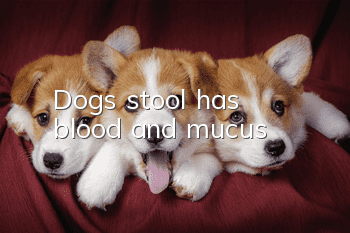Dog's stool has blood and mucus

Dogs with blood and mucus in their stools are caused by parvovirus
Symptoms:
In the early stage of parvovirus infection, there will be a loss of appetite. Apathetic. After parvovirus expands, it will damage the dog's intestinal mucosa and gastric mucosa, causing the shed blood vessels to be exposed, and the stool will be red and thin with a smell in the later stage.
Solution:
1. Most of the puppies infected with parvovirus are puppies. If you find the corresponding symptoms, you should eat and drink immediately, because drinking water will bring gastrointestinal infection to the dog. This creates additional burden and makes subsequent treatment more difficult. Secondly, you should send it to a pet hospital as soon as possible and follow the doctor's instructions for treatment. The earlier a small infection is treated, the greater the cure rate.
2. If there are multiple dogs in the home, they should be isolated, and the dog’s living area and daily utensils should be disinfected. Dogs living in the same environment as the affected dog should also go to the hospital to check whether they are infected with parvovirus.
Blood and mucus in dog stools are caused by parasites
Symptoms:
If the dog Blood and mucus in the stool may be caused by not deworming in time. For example, roundworms attach to the intestinal wall of the dog for a long time, causing damage to the intestines, rupture of blood vessels and internal bleeding, which will cause blood and mucus in the dog's stool. . The stool is thin and bloody. In addition, the dog will also have symptoms of increased body temperature, but the appetite will not be affected. If you suspect that this is the case, it cannot be distinguished with the naked eye. You need to take the sick dog's stool to the hospital for testing to detect whether there are parasites.
Solution:
1. Puppies should be dewormed internally and externally once a month, and adult dogs should be dewormed internally and externally once every three months. Those who go out frequently Dogs should be kept clean and dewormed.
2. During the deworming period, the dog will have gastrointestinal discomfort and symptoms of vomiting and diarrhea. It can be treated with some probiotics. Pay attention to supplement nutrition and water to avoid electrolyte imbalance caused by excessive vomiting and diarrhea.
Dogs with blood and mucus in their stools are due to gastroenteritis
Symptoms:
Pulmonary gastrointestinal discharge caused by parvovirus In general, if the food in the dog's stomach is not digested for a long time, it will induce acute enteritis. In the later stage, if the condition worsens, the dog will have blood in the stool. On the first day of gastroenteritis, you will have fever, diarrhea, bloody stools, dry nose, dehydration, sunken eyeballs and other symptoms.
Solution:
1. Fast for 24 hours, drink a small amount of water, and mix a small amount of glucose powder and 1g of salt in the water to avoid dehydration of the dog. Then send it to a pet hospital for symptomatic treatment.
2. During the treatment period, broth, milk, starch paste, etc. can be given to gradually thicken until the patient recovers and returns to normal diet.
Blood and mucus in dog stools is due to anal gland abscess
Symptoms:
Dogs There will be rubbing on the buttocks, lack of energy, restlessness, loss of appetite, constipation or difficulty in defecation, etc. After defecation, the anal area will be bitten, and thick juice, reddish-brown smelly liquid will appear when wiped with paper.
Solution:
1. Prepare scissors, gauze, alcohol, and gloves. Wash your hands, disinfect them, and wear gloves to clean the hair around the dog’s anus.
2. Place your index finger and thumb on both sides of the anus, squeeze the anal glands from bottom to top, and squeeze out the pus. After squeezing out, apply erythromycin or gentamicin to the affected area, disinfect it three times a day, and apply medicine after disinfection. If the anal glands become hard and cannot squeeze out pus, you should go to a pet hospital for treatment or removal.
- Symptoms of a Golden Retriever before he dies. Things to note before the Golden Retriever dies.
- How to care for the coat of a Toy Manchester Terrier
- How to prevent Toxoplasma gondii infection? What are the preventive measures?
- What are the prenatal signs of Chinese Garden Dogs?
- What medicine should dogs take when they have a cold? Things to note when dogs have a cold
- Can pet dogs be transported by air? Things to note when transporting pet dogs by air
- Is cdv canine distemper or parvovirus cdv canine distemper symptoms and prevention
- What should you pay attention to when raising Jugui?
- After reading the shortcomings of Labrador, do you still dare to keep it?
- Can pregnant women pet their own dogs? What should I pay attention to when raising a dog during pregnancy?



